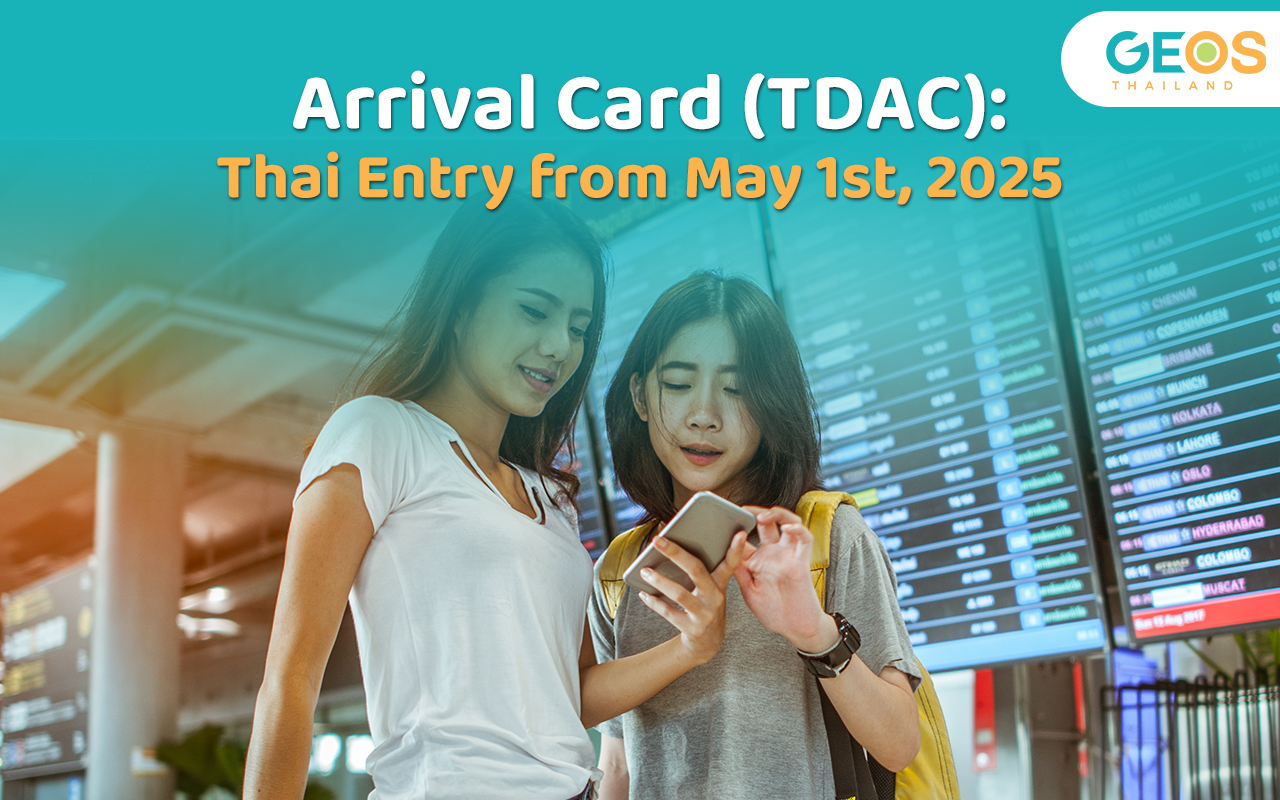
Thailand’s New Digital Arrival Card Requirement in 2025
If you’ve ever taken a trip to Thailand, you probably remember that little blue-and-white paper arrival card — the TM6 form. It asked where you’d stay, your flight number, and maybe forced you into a rushed handwriting panic upon arrival. Sound familiar?
Well, starting May 1st, that old form is going away.
Thailand is introducing the TDAC system, a new digital arrival card that’s now mandatory for all foreign passport holders entering Thailand by air, land, or sea.
✈️ New to long-stay travel in Thailand? Make sure you also understand how re-entry permits work if you’re planning to leave and return.

What’s Replacing the TM6?
The TDAC, or Thailand Digital Arrival Card, is the country’s latest move to modernize immigration processing. Instead of scribbling on a traditional paper form, you’ll complete the TDAC online before you travel. It’s easy, and it saves time.
If you’re heading to Thailand — whether for study, travel, or work — you’ll need to submit your TDAC and show a QR code upon arrival at the immigration checkpoint.
For foreign nationals entering Thailand, this is now part of the process.
What You Need to Do Before You Arrive in Thailand
To register for the TDAC, here’s what to do:
1) Go to the official TDAC website: tdac.immigration.go.th
2) Submit your TDAC application online before arrival — ideally 1 to 3 days before your arrival date
3) Fill in your details:
- Personal info and passport details
- Arrival information (flight, port of entry)
- Where you’ll stay in Thailand
- A short health declaration
4) Once you’re done, you’ll get a TDAC confirmation with a QR code — keep it handy on your phone or print it out (just in case)
You must complete a TDAC even if you’re not applying for a visa. The card is not a visa.
🧳 Just arriving? You’ll also need to understand how to do 90-day reporting if you’re staying longer than three months.
Who Must Submit a TDAC, and Who Doesn’t?
All non-Thai nationals entering Thailand are required to complete the Thailand Digital Arrival Card before arrival.
But there are a couple of exceptions to keep in mind.
You must submit a TDAC if you are:
- A foreign national entering Thailand by air, land, or sea
- Visiting on a tourist, ED, business, or long-stay visa
- A permanent resident or long-term expat re-entering Thailand
- A student arriving for a language course (yes, that includes ED visa holders)
You do not need to submit a TDAC if:
- You are transiting or transferring through Thailand without passing through immigration control
- You are entering Thailand using a Border Pass at designated checkpoints
So, if you’re flying in for study or travel and plan to go through immigration, then yes, the TDAC will be mandatory for you.
ED Visa Students: Pay Attention
If you’re an ED visa holder, this is important. Even though this new digital system doesn’t change how you apply for or extend your ED visa, you must register for the TDAC if you’re entering the country or doing a visa run.
Most of our students at GEOS apply after arriving in Thailand, and from now on, you’ll need to fill out the TDAC before every new entry.
Studying Thai or English? Make sure you submit the form in the days before arrival — ideally as soon as your travel plans are confirmed.
Why Thailand Is Doing This
The Immigration Bureau’s goal is to:
- Streamline immigration procedures
- Reduce the use of traditional paper arrival cards
- Increase efficiency at immigration checkpoints
- Help check the criminal backgrounds of international arrivals more effectively
It’s a big change, but a welcome one, especially for permanent foreign residents in Thailand who travel often and are used to manual paper forms.
What to Expect When You Arrive
Whether you’re visiting Thailand for the first time or returning as a student, here’s what we recommend:
- Submit the TDAC 2–3 days before your flight
- Screenshot your QR code just in case you lose internet access
- Make sure your arrival date and address in Thailand are accurate
- Don’t panic if the immigration officer upon arrival asks to see it — it’s now standard procedure
💡 If you plan to open a bank account while studying in Thailand, check out our guide to bank accounts for foreigners.
What Our Students Are Saying
Some of our students at GEOS have already used the new TDAC system during recent trips, and so far, the feedback has been overwhelmingly positive.
They’ve told us the online form is straightforward, the confirmation arrives quickly, and the QR code makes arrival at immigration smoother than before. A few mentioned it felt like the airport process was faster, with fewer paper checks and delays.
We’ll continue to collect feedback as more students use the system, but if you’re worried about the change, don’t be. It’s working well so far.
Quick Tip for Students at GEOS
At GEOS, we’re already helping students through the TDAC registration as part of their onboarding. So, if you’re unsure how to fill it out or when to do it, we’re here to help. Just ask — we’ll walk you through the whole thing.
Whether you’re arriving on May 1st, coming back from a weekend trip, or just planning your first travel to Thailand, the new TDAC is now part of the deal.
Final Thoughts
This new Thailand digital arrival card doesn’t change your visa. It’s just one more step in making sure your arrival in Thailand is smooth and secure.
And no more searching for a pen mid-flight.
Need Help?
If you’re a non-Thai national entering Thailand, and especially if you’re a student on an ED visa, we’re here to help with your arrival, paperwork, and settling in.
Studying at GEOS? We’ll take care of it together.
Not a student yet? Contact us for a free consultation to get started.
Additional FAQs About the Thailand Digital Arrival Card (TDAC)
Yes. Every single trip. Whether you’re on a tourist visa, ED visa, or long-term stay, the TDAC is now part of re-entering Thailand.
Small typo? You might be fine. However, if you make a major error — such as your passport number or name — it’s best to play it safe and submit a new one.
Yes, but here’s the good news — you don’t need to fill out a brand-new form for each child. On the health declaration page (Page 3 of the TDAC form), there’s an option to add more passengers, like your spouse or kids. Just make sure everyone’s details are accurate. It’s still one QR code, but it covers the whole family.
No stress. You can leave that field blank if needed. But be ready — an immigration officer might ask when you plan to leave, so having a rough idea helps.
Not yet. For now, you’ll need to complete the TDAC at tdac.immigration.go.th — best done on a laptop or mobile browser.
A screenshot on your phone works fine. But if you’re the “just in case” type, printing a backup isn’t a bad idea. Airport Wi-Fi is not always your friend.
First, check your spam folder (classic). If it’s still missing, don’t panic — just head back to the TDAC site and re-download it from your application history.
Technically, yes — there are machines at the airport and staff to help you out. But be warned: if you’re landing during a busy period, expect long queues and delays. Most people will leave it to the last minute, and that means bottlenecks. Our advice? Get it done online 1–3 days before your flight. It takes just a few minutes and saves you a heap of airport stress.
If you’re not officially entering the country (i.e., you’re staying in the transit zone), you’re off the hook. But if you plan to go through immigration — even for a short stay — the TDAC is required.
No. The TDAC is completely free. If a website asks for payment, it’s probably not the real deal. Stick with the official site, and don’t get scammed.
Explore Our Magazine
Explore our collection of captivating articles, each offering a unique perspective



